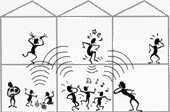Noise
Neighbourhood Noise Problems
The problems of neighbourhood noise are well reported. Statements like: 'I can hear my neighbour's television', and 'I can hear the people upstairs walking about' are becoming increasingly common. We must also not forget the amateur musician or the home cinema enthusiast who cannot enjoy their hobby for concerns of disturbing the neighbours.
The Chartered Institute of Environmental Health report that noise complaints to local authorities have doubled over the past five years. Interestingly, their members suggest that the main reason for the increase is peoples higher (and maybe unrealistic) expectations of tranquility in their homes. So, if you are experiencing noise problems, maybe the first thing to do is to ask yourself whether you are asking for an unrealistic environment for your location. Total peace and quiet is hard to achieve in highly populated urban areas.

Tearing up the carpets and having a polished wooden floor has become increasingly popular. Whilst this may make aesthetic sense, the increase in footfall noise in rooms below can cause problems. Indeed, there may be leasehold restrictions on a property preventing such modifications.
However, as is frequently the case, money can buy higher quality of life. It is possible to achieve the silence of rural church crypt in a city location - but this requires substantial financial investment. Civil Engineering Dynamics aim to provide high quality, bespoke solutions, hand made to suit the client's unique environment and tastes. For the ultimate in domestic sound insulation, see the Civil Engineering Dynamics Quiet Haven.
The Principles of Domestic Sound Insulation
Fundamentally, the principles of increasing the sound insulation in a building are simple - you need to provide the most torturous path for the sound to travel to and from you and your neighbour's rooms.
Sound tends to travel between rooms in two ways - along airborne paths (through open windows, flues or ductwork etc.), or along structureborne paths (through walls, floors, closed windows etc.). Obviously, most paths are a combination of both. For example, if you shout, the sound is airborne from your mouth to the walls, structureborne through the walls, and then re-radiated as airborne sound to your neighbour's ears. Footfalls are mainly straight into the floor as structureborne sound, and then re-radiated as airborne in the room below.
Therefore, solutions tend to either limit, or sever structureborne paths wherever possible, and to increase the mass of any partition, or provide additional partitions, as the change from airborne to structureborne (or vice versa) reduces the energy of a sound wave.

